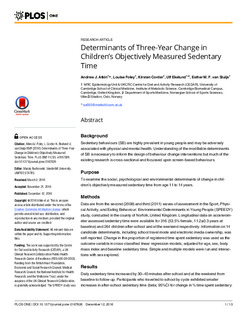| dc.contributor.author | Atkin, Andrew J. | |
| dc.contributor.author | Foley, Louise | |
| dc.contributor.author | Corder, Kirsten | |
| dc.contributor.author | Ekelund, Ulf | |
| dc.contributor.author | van Sluijs, Esther M. F. | |
| dc.date.accessioned | 2017-01-31T09:39:38Z | |
| dc.date.available | 2017-01-31T09:39:38Z | |
| dc.date.issued | 2016-12-12 | |
| dc.identifier.citation | PLoS ONE. 2016. doi: http://dx.doi.org/10.1371/journal.pone.0167826 | nb_NO |
| dc.identifier.uri | http://hdl.handle.net/11250/2429003 | |
| dc.description.abstract | Background: Sedentary behaviours (SB) are highly prevalent in young people and may be adversely associated with physical and mental health. Understanding of the modifiable determinants of SB is necessary to inform the design of behaviour change interventions but much of the existing research is cross-sectional and focussed upon screen-based behaviours. Purpose: To examine the social, psychological and environmental determinants of change in children’s objectively measured sedentary time from age 11 to 14 years. Methods: Data are from the second (2008) and third (2011) waves of assessment in the Sport, Physical Activity, and Eating Behaviour: Environmental Determinants in Young People (SPEEDY) study, conducted in the county of Norfolk, United Kingdom. Longitudinal data on accelerometer assessed sedentary time were available for 316 (53.5% female, 11.2±0.3 years at baseline) and 264 children after-school and at the weekend respectively. Information on 14 candidate determinants, including school travel mode and electronic media ownership, was self-reported. Change in the proportion of registered time spent sedentary was used as the outcome variable in cross-classified linear regression models, adjusted for age, sex, body mass index and baseline sedentary time. Simple and multiple models were run and interactions with sex explored. Results: Daily sedentary time increased by 30–40 minutes after-school and at the weekend from baseline to follow-up. Participants who travelled to school by cycle exhibited smaller increases in after-school sedentary time (beta; 95%CI for change in % time spent sedentary: -3.3;-6.7,-0.07). No significant determinants of change in weekend sedentary time were identified. Conclusions: Time spent sedentary increased during the three-year duration of follow-up but few of the variables examined were significantly associated with changes in sedentary time. Children’s mode of school travel may influence changes in their sedentary time over this period and should be examined further, alongside broader efforts to identify modifiable determinants of SB during childhood. | nb_NO |
| dc.language.iso | eng | nb_NO |
| dc.publisher | PLOS | nb_NO |
| dc.subject | behavior | nb_NO |
| dc.subject | schools | nb_NO |
| dc.subject | accelerometers | nb_NO |
| dc.subject | games | nb_NO |
| dc.subject | physical activity | nb_NO |
| dc.subject | children | nb_NO |
| dc.subject | video games | nb_NO |
| dc.subject | body mass index | nb_NO |
| dc.title | Determinants of three-year change in children’s objectively measured sedentary time | nb_NO |
| dc.type | Journal article | nb_NO |
| dc.type | Peer reviewed | nb_NO |
| dc.subject.nsi | VDP::Matematikk og Naturvitenskap: 400::Basale biofag: 470 | nb_NO |
| dc.subject.nsi | VDP::Landbruks- og Fiskerifag: 900::Landbruksfag: 910 | nb_NO |
| dc.source.journal | PLoS ONE | nb_NO |
| dc.identifier.doi | http://dx.doi.org/10.1371/journal.pone.0167826 | |
| dc.description.localcode | Seksjon for idrettsmedisinske fag / Department of Sports Medicine | nb_NO |
